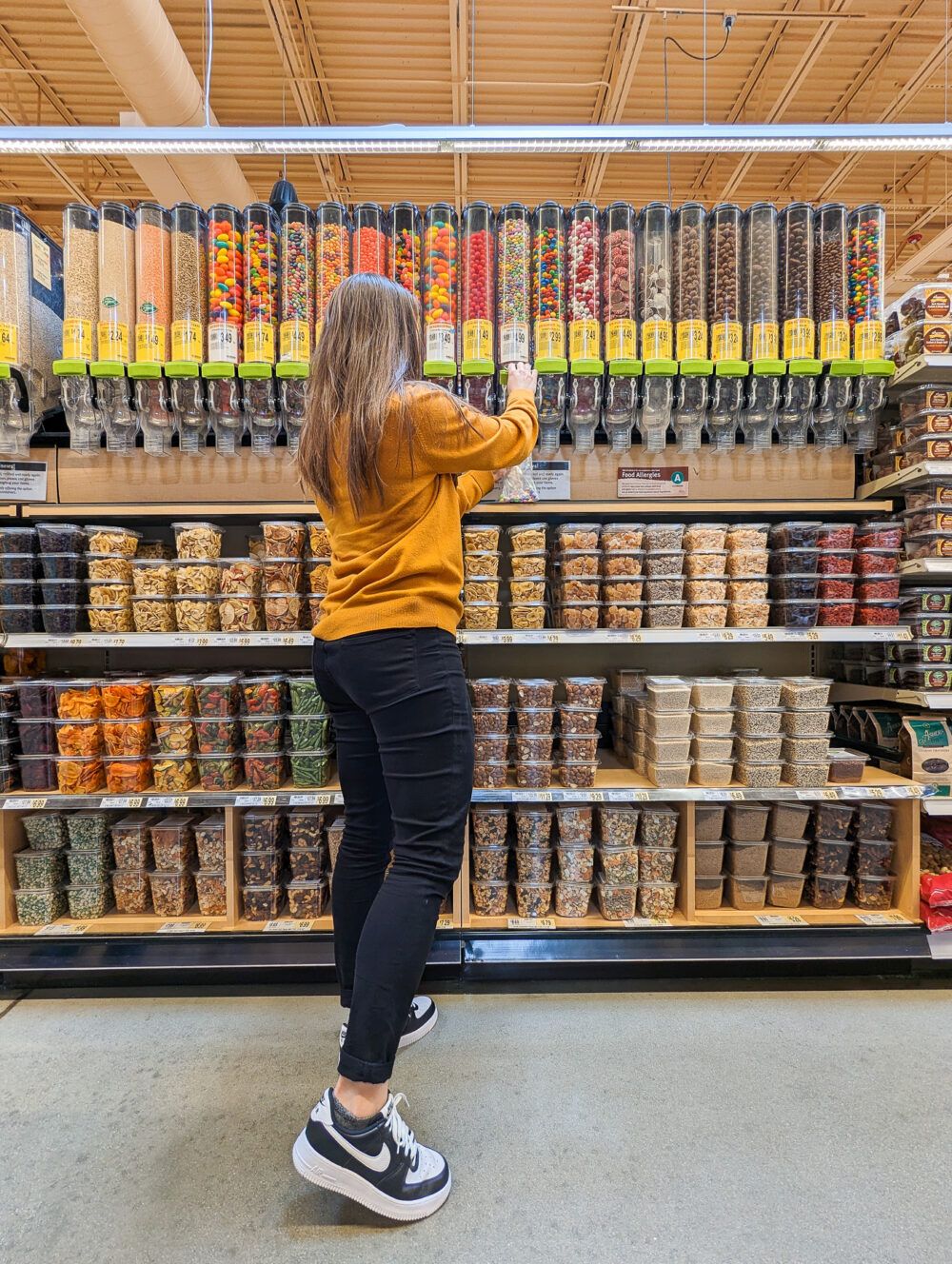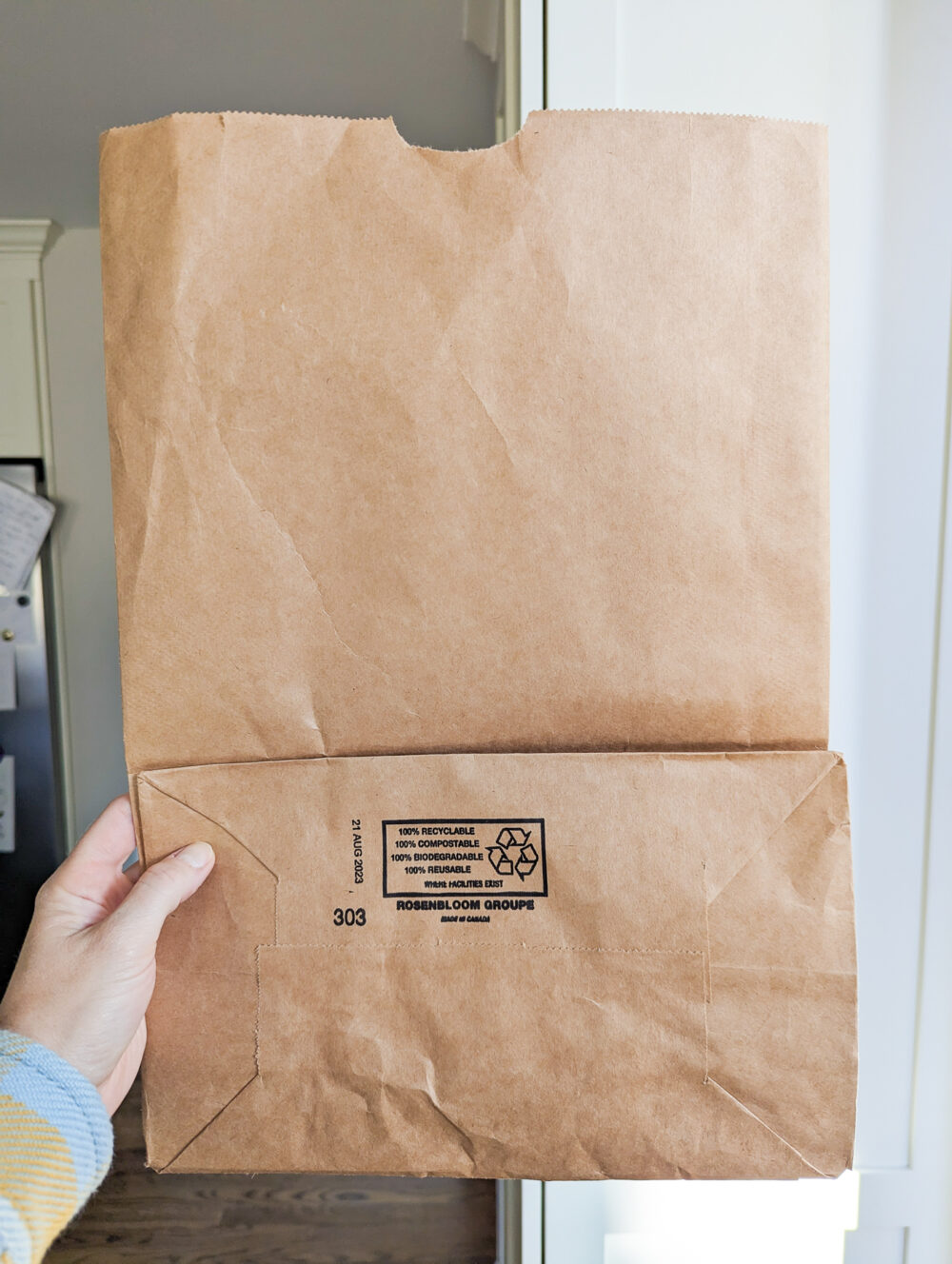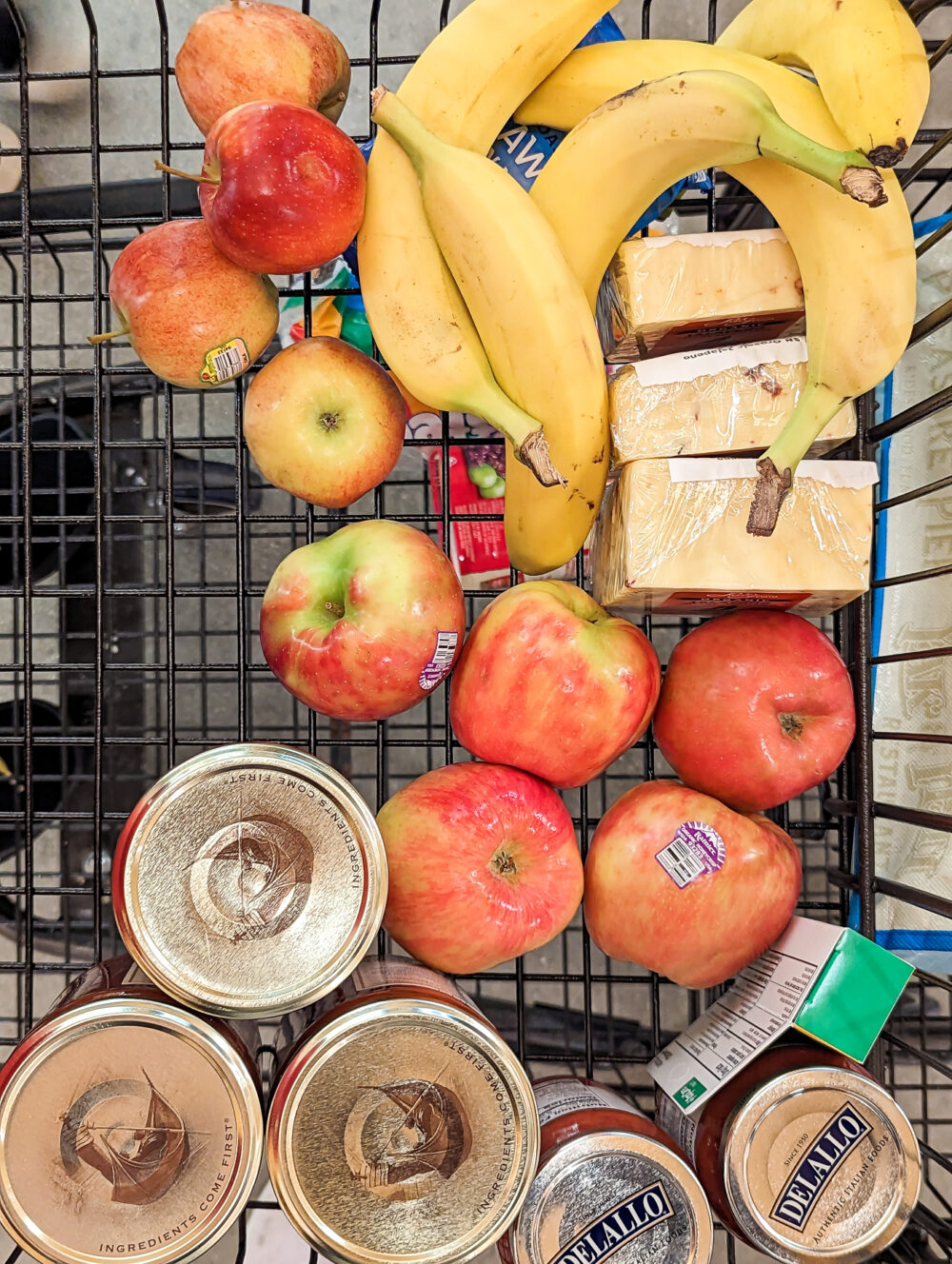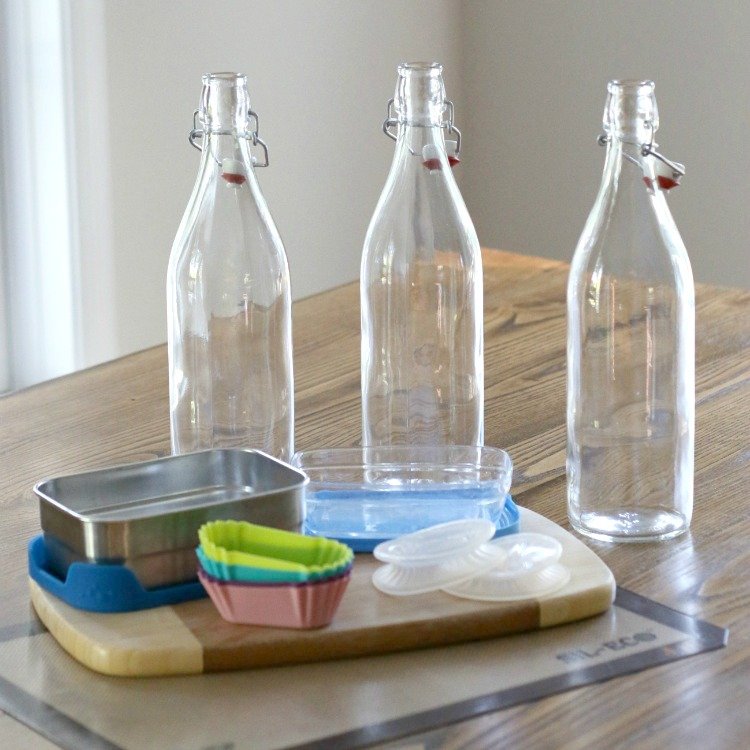Easy Sustainable Grocery Delivery Tips That Work For Us
Can grocery shopping be sustainable? Read on for some tips sustainable grocery delivery tips we incorporate to make our online grocery shopping a little more eco-friendly.

Shortly after online grocery delivery began (more years ago than I can even recall), I ordered our groceries for delivery and received a bunch of very green bananas. I did not care for green bananas.
While I’m sure there were plenty of other items in my order that were just fine, I only remember these green bananas and lots of produce bags. So much plastic!
For years, I avoided grocery delivery from traditional grocery stores after that one negative experience. I didn’t mind shopping in-store where I could use my reusable bags, skip produce bags, look for items in better packaging, and have full control over what I put in my cart. Everything was fine and dandy.

But over the last few years, I’ve started to loathe grocery shopping. It feels like such a slog, especially when I’m being pulled in so many other directions. As more of my friends use online grocery delivery regularly, I decided to give it another try. And… I am hooked!
The technology now is much better (to be expected) so I have quite a bit more control over the items I order, how they are packaged, and how much plastic ends up in my bags. I can chat in real time with shoppers about alternatives if things are out of stock.
And I’m over the banana business. I eat a lot more smoothies with bananas in them, so if green bananas go brown too quickly, they go into the freezer and end up in smoothies. It’s no big deal. (P.S. This banana, mango, spinach, and pineapple smoothie with yogurt is my favorite… if you’re curious.)


Initial hesitations about sustainable grocery delivery
As an eco-nerd, I had a few hesitations about online grocery delivery, most of which I’ve resolved as I describe below. Excess packaging was my primary concern, as everything else in the order would be much the same if I shopped myself. But I’m able to influence most of the packaging decisions.
It was also important to me that the delivery gig worker I hired received fair compensation for their work. I didn’t want to be exploiting my privilege of being able to afford grocery delivery service by making someone else work for unfair wages.
In my opinion, the amount they receive from the companies alone is not sufficient to compensate them for the time and benefit I receive, so adequate tipping felt important to ensure a fair exchange of services and pay.
Grocery delivery reduces food waste
So many of us are moving in a lot of directions, and predictable and easy grocery shopping can make a lot of things about sustainable living easier. We can meal plan and prep food when we would otherwise be shopping. We stick to lists more diligently when food shopping online instead of wasting money or resources buying things we don’t need.
With a plan, it’s much easier to use the food we have without letting it go to waste instead of panicking every evening trying to decide what to eat between extracurricular activities, only to end up not eating the things nearly rotting in the fridge.
As we think about how sustainable online food shopping might fit into eco-conscious lives for everyday families, let’s dive into some sustainable grocery delivery tips to save time, reduce food waste, and save money while also making choices that are a little better for the planet.

Simple Sustainable Grocery Delivery Tips
As you place your online grocery delivery order, you can make choices that are better for the environment by picking the right products, thinking about packaging, being smart with your delivery scheduling, and paying delivery drivers fair wages. Let’s take a deeper look at each of these considerations.

Choose Eco-Friendly Grocery Products
There are lots of ways to make more sustainable choices for grocery products. But these apply if you’re shopping yourself or if you’re using a delivery service, so I’ll just mention them briefly (even though they could each warrant their own encyclopedia).
- Look for Labels: Find products certified as organic, non-GMO, and compostable. These choices may help reduce your environmental impact. Some labels mean more than others, so look for those with verified certifications if you want to be sure the language has teeth and is more than a marketing message.
- Plant-based proteins: Incorporate plant-based proteins into some of your meals. I believe that meat (without consideration of nuance) isn’t necessarily the biggest environmental problem, but the volume of meat that we collectively eat is a problem because that informs how the meat is produced (and that’s the real problem).
- Sustainable Meats: Look for meats that are local, grass-fed and finished, sustainably farmed, etc… Here are some more tips about how to eat meat more sustainably beyond Meatless Monday.
- Choose Local: To the extent possible, choose food items that are from local farmers and producers in your area. These should have lower transportation footprints and be fresher because they haven’t traveled all across the world to get to you. It’s also great to support your local community!
- Buy Bulk: Purchase items in bulk to minimize packaging waste. Fewer packages mean less material to recycle or throw away. Do your best to ditch single-serving packages entirely.
- Opt for Sustainable Packaging: Look for items that come in more sustainable packaging, items that are recyclable, compostable, or can be reused many times. These are better than single-use plastic that can’t be repurposed. Seek out products with minimal packaging or those labeled as environmentally friendly. Prioritize items without unnecessary layers of plastic or boxes.

Reduce Grocery Delivery Order Packaging Waste
Anticipated mounds of excess plastic heightened my hesitation to have my groceries delivered. But it turns out I haven’t had too much of an issue with that.
Leave notes about preferred packaging options
I can leave notes throughout the grocery order requesting the shopper to skip produce bags and use only paper bags for transport. I put a note next to each produce item as a reminder to skip plastic produce bags. And I put a note at the end of the order to request brown paper bags. Only one time did I receive reusable plastic bags instead of brown paper bags, and I can keep those for future use.
Reuse and donate grocery bags
If I shopped on my own, I’d bring reusable bags for checkout. But that’s not an option when I choose grocery delivery. However, I’m still able to put the brown paper bags to good use.
- I keep a stash of brown paper bags as liners for my compost buckets. These are by far the best at keeping the inside of the 5-gallon plastic food scrap container clean, so I’m happy to have a handful on hand for my buckets and those I give to my in-laws for their compost bins too.
- I donate extra brown paper bags to the food pantry in our community so participants can use them when they shop at the pantry. They don’t have reusable options, so these single-use bags get an extra life helping those in need.
- I’ve also used the brown paper bags to line our recycling bin, as sustainable gift wrap for birthday and holiday gifts, and as something to kneel on when I’m working in the garden.
- If you can’t find a home for them in your house, I bet you could collect them and give them away in a community gifting group (like Buy Nothing) from time to time. You’d be surprised how many people can put the most random things to good use!
Digital Receipts and Invoices
It’s all in the app, so no paper receipts required! It may be small, but it all adds up. And each step is one step closer to zero waste. Take the wins where you can get them. Did you know that most receipts are made with coated paper so they aren’t even recyclable?

Optimize Delivery Schedules
There are a few ways you can have a small impact on the carbon footprint of your order by choosing wisely when you place your order and request delivery of it. These impacts won’t likely be gigantic, but every little bit helps and builds momentum toward more sustainable habits overall.
- Consolidate Orders: Try to shop for everything you need at once. Make a list and make a plan to order once a week, once every two weeks, or whatever is the least frequent cadence that works for you. This reduces the number of delivery trips a shopper has to make.
- Off-Peak Deliveries: Particularly if you live in an area with lots of traffic, request deliveries during off-peak hours to help lower the carbon footprint. This helps reduce the number of vehicles on the road when it’s busier and means your driver has to idle less in traffic, a waste of both time and fuel.
- No Rush: If you don’t need your groceries immediately, select a delivery time that allows for multiple orders to be combined. This makes for more efficient trips.

Ethical Delivery Compensation Considerations
As I mentioned above, when it comes to grocery delivery, it’s important to consider fair compensation for your delivery person. Tips are more than just a kind gesture; they can make a substantial difference in someone’s earnings.
Over many centuries, certain groups of people have gotten ahead and exploited their privilege by asking others to do their domestic labor for less-than-fair wages. In the environmental space, we see all sorts of environmental justice inequities where those with privilege are leaving behind trails of suffering and inequity in the wake of their pursuit of prosperity – in general and concerning climate solutions.
It’s not directly related to climate action, and I won’t ever be perfect. But I wanted to do my best to make sure I don’t reinforce that inequity. So I asked a lot of people what they thought a fair tip might be.
What’s a fair tip for the grocery delivery person?
After extensive discussion with my family and quite a few thoughtful responses to the same question on Instagram, there were a variety of answers. But a consensus emerged among many. A large group thought that a 15%-20% tip with both a floor and a ceiling was reasonable. Thus, the starting point for calculating that tip was 15-20% times the value of my order.
Establishing a floor and a ceiling
The floor and ceiling were both based on the expected time and effort to complete the shopping and delivery services, multiplied by an acceptable hourly rate for the time and value of the services. For example, if I anticipate the services take one hour to complete and I want to provide $15/hour of work, I set a floor for the tip to be at least $15.
On the opposite end, if I have a particularly expensive order based on what I’m buying and the tip based on % of the cost feels excessive, I might set a ceiling at $30/hr based on the estimated time for completion of shopping and delivery.
Variables that impact tip amount
People also weighed in with variables that might shift that floor or ceiling up or down. Some of the factors included:
- increasing the tip if items were especially heavy (including items like dog food)
- increasing the tip if the weather is bad
- increasing the tip if there were a lot of items, even if those items were small and inexpensive (more shopping time even though the cost of the order is lower)
- decreasing the tip if there were few items, even if those items were expensive (less shopping time even though the cost of the order is high)
- giving a larger tip if you live farther from the grocery store (more driving distance – gas expense and time)
The cost of living in an area also came up in the discussion. Those who lived in places with high costs of living consistently expected tips to be higher than those in areas with lower costs of living.
Appropriate tips reinforce equity
This may not be consistent with what Instacart or other delivery services expect. I think the default tip on Instacart is 5% of the cost of your groceries. I’m not telling anyone what is right for them, so decide what feels best for you.
But I do think it’s important that we provide a sufficient tip that tells the shopper we respect and value the work they are doing. If it wasn’t important to you or me to have someone else shop for us, we wouldn’t be asking them to provide the service. What do you think your time is worth? And how does that inform the value of the time of the person doing the work for you?
Moreover, shoppers see tips before they accept orders, so some assessment of the fairness of tips will presumably happen by the shoppers themselves. They may not accept orders for fees that they feel are too low. And they may not provide the best service if the tip doesn’t feel adequate.
Can you leave a cash tip instead of tipping through the app?
Yep! But I’m not sure it’s the best option. The shoppers see the planned tip in the app when they select which orders to fill. If they don’t expect the additional cash tip at the end, your order might not receive the same quality attention if the shoppers know what to expect in advance.
I’ve never thought to give a cash tip. I think it’s easier to do it all within the app. Also, I include instructions to leave the order on our doorstep, so I don’t always see the delivery person. Sometimes I’m not even home when the order arrives.
Is it possible to change the tip amount after my delivery is completed?
Yes, you have the option to adjust the tip amount for up to 24 hours after delivery to better reflect the service you received.
What exactly is tip baiting, and why is it frowned upon?
Tip baiting, where a large tip is offered initially and then reduced or removed after delivery, is deeply frowned upon because it misleads drivers about their expected compensation. I’d never thought to do this until I read about it online. Just don’t do this; don’t be a jerk.
If service is terrible, adjust the tip accordingly as you see fit. But offering crappy tips even when service is good not only harms the driver but also hurts the industry overall and makes it harder for everyone to have a trustworthy and value-driven experience.

Is sustainable grocery delivery the best option for the planet?
I don’t know. If you weren’t hiring someone else to shop and drive, you’d be doing it anyway, right? There are so many factors to consider. Whether or not it’s “more sustainable” than shopping on your own depends on a laundry list of factors.
Despite all that, these sustainable grocery delivery tips will make your eco-friendly food shopping goals more achievable than relative to choosing not to use them at all. Let’s all focus on doing the things we can do as best we can and make collective progress toward better choices incrementally.
What else did I miss? Perhaps you’ll share a few sustainable grocery delivery tips of your own in the comments.
If you like this post about sustainable grocery delivery, you might also like
7 Tips to Reduce Food Packaging Waste
6 Ways to Donate to a Food Pantry and Reduce Food Waste

Jen Panaro
Jen Panaro, founder and editor-in-chief of Honestly Modern, is a self-proclaimed composting nerd and advocate for sustainable living for modern families. To find her latest work, subscribe to her newsletter, Stepping Stones.
In her spare time, she’s a serial library book borrower, a messy gardener, and a mom of two boys who spends a lot of time in hockey rinks and on baseball fields.
You can find more of her work at Raising Global Kidizens, an online space to help parents and caregivers raise the next generation of responsible global citizens.







